ESP Citroen C3 RHD 2012 2.G Owner's Guide
[x] Cancel search | Manufacturer: CITROEN, Model Year: 2012, Model line: C3 RHD, Model: Citroen C3 RHD 2012 2.GPages: 252, PDF Size: 8.17 MB
Page 127 of 252

9
125
DRIVING
SPEED LIMITER
System which prevents the vehicle from
exceeding the speed programmed by
the driver.
When the programmed speed limit is
reached, pressing the accelerator pedal
in the normal manner no longer has any
effect.
The speed limiter is switched on
ma-
nually: it requires a programmed speed
of at least 20 mph (30 km/h).
The speed limiter is switched off
by
manual operation of the control.
The programmed speed can be exceeded
temporarily by pressing the accelerator
fi rmly.
To return to the programmed speed,
simply slow down to a speed below the
programmed speed.
The programmed speed remains in the
memory when the ignition is switched off.
The speed limiter cannot, in any
circumstances, replace the need
to respect speed limits, nor can
it replace the need for vigilance
and responsibility on the part of
the driver.
Steering mounted controls
The controls of this system are grouped
together on stalk A
.
1.
Speed limiter mode selection thumb
wheel.
2.
Value decrease button.
3.
Value increase button.
4.
Speed limiter on/off button.
Displays in the instrument panel
The programmed information is grouped
together in the instrument panel screen.
5.
Speed limiter on/off indication.
6.
Speed limiter mode selection
indication.
7.
Programmed speed value.
Page 129 of 252
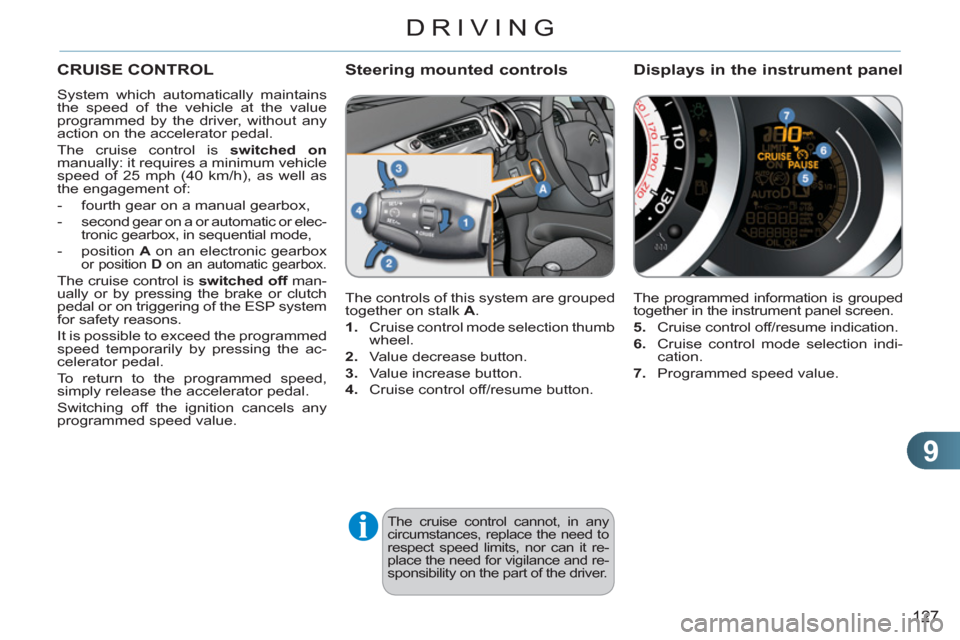
9
127
DRIVING
The cruise control cannot, in any circumstances, replace the need to respect speed limits, nor can it re-
place the need for vigilance and re-
sponsibility on the part of the driver.
CRUISE CONTROL
System which automatically maintains
the speed of the vehicle at the value
programmed by the driver, without any
action on the accelerator pedal.
The cruise control is switched on
manually: it requires a minimum vehicle
speed of 25 mph (40 km/h), as well as
the engagement of:
- fourth gear on a manual gearbox,
- second gear on a or automatic or elec-
tronic gearbox, in sequential mode,
- position A
on an electronic gearbox
or position D
on an automatic gearbox.
The cruise control is switched off
man-
ually or by pressing the brake or clutch
pedal or on triggering of the ESP system
for safety reasons.
It is possible to exceed the programmed
speed temporarily by pressing the ac-
celerator pedal.
To return to the programmed speed,
simply release the accelerator pedal.
Switching off the ignition cancels any
programmed speed value. The controls of this system are grouped
together on stalk A
.
1.
Cruise control mode selection thumb
wheel.
2.
Value decrease button.
3.
Value increase button.
4.
Cruise control off/resume button.
Steering mounted controls
Displays in the instrument panel
The programmed information is grouped
together in the instrument panel screen.
5.
Cruise control off/resume indication.
6.
Cruise control mode selection indi-
cation.
7.
Programmed speed value.
Page 132 of 252

9
130
DRIVING
The system will be deactivated
automatically when towing a
trailer or when a bicycle carrier is
fi tted (vehicle fi tted with a towbar
or bicycle carrier recommended
by CITROËN). In bad or wintry weather, ensure
that the sensors are not covered
with mud, frost or snow.
Programming
You can activate or deactivate the
system by means of the multifunction
screen confi guration menu. The system
state is memorised when switching off
the ignition.
For more information on access to
the parking sensors menu, refer to
"Confi guration/Vehicle parameters" in
the "Multifunction screens" section cor-
responding to your screen.
Operating faults
If there is an operating fault,
when reverse gear is engaged
this warning lamp comes on
in the instrument panel, accompanied by
an audible signal (short beep) and a mes-
sage in the multifunction screen.
Page 137 of 252
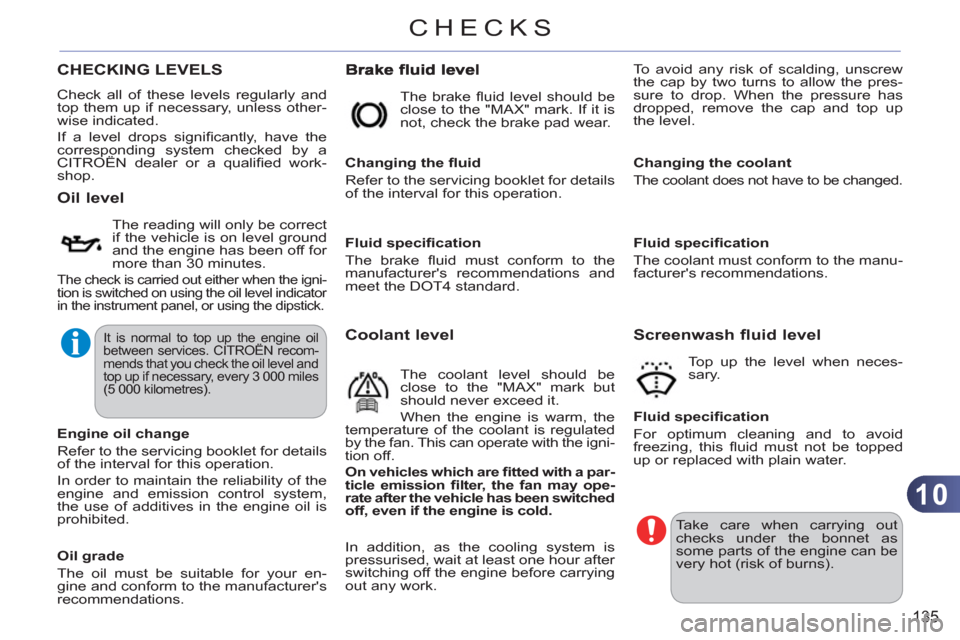
10
135
CHECKS
CHECKING LEVELS
Check all of these levels regularly and
top them up if necessary, unless other-
wise indicated.
If a level drops signifi cantly, have the
corresponding system checked by a
CITROËN dealer or a qualifi ed work-
shop.
Oil level
The reading will only be correct
if the vehicle is on level ground
and the engine has been off for
more than 30 minutes.
The check is carried out either when the igni-
tion is switched on using the oil level indicator
in the instrument panel, or using the dipstick.
Engine oil change
Refer to the servicing booklet for details
of the interval for this operation.
In order to maintain the reliability of the
engine and emission control system,
the use of additives in the engine oil is
prohibited.
Oil grade
The oil must be suitable for your en-
gine and conform to the manufacturer's
recommendations.
The brake fl uid level should be
close to the "MAX" mark. If it is
not, check the brake pad wear.
Changing the fl uid
Refer to the servicing booklet for details
of the interval for this operation.
Fluid specifi cation
The brake fl uid must conform to the
manufacturer's recommendations and
meet the DOT4 standard.
Coolant level
The coolant level should be
close to the "MAX" mark but
should never exceed it.
When the engine is warm, the
temperature of the coolant is regulated
by the fan. This can operate with the igni-
tion off.
On vehicles which are fi tted with a par-
ticle emission fi lter, the fan may ope-
rate after the vehicle has been switched
off, even if the engine is cold.
In addition, as the cooling system is
pressurised, wait at least one hour after
switching off the engine before carrying
out any work. To avoid any risk of scalding, unscrew
the cap by two turns to allow the pres-
sure to drop. When the pressure has
dropped, remove the cap and top up
the level.
Changing the coolant
The coolant does not have to be changed.
Fluid specifi cation
The coolant must conform to the manu-
facturer's recommendations.
Screenwash fluid level
Top up the level when neces-
sary.
Fluid specifi cation
For optimum cleaning and to avoid
freezing, this fl uid must not be topped
up or replaced with plain water.
Take care when carrying out
checks under the bonnet as
some parts of the engine can be
very hot (risk of burns).
It is normal to top up the engine oil
between services. CITROËN recom-
mends that you check the oil level and
top up if necessary, every 3 000 miles
(5 000 kilometres).
Page 152 of 252
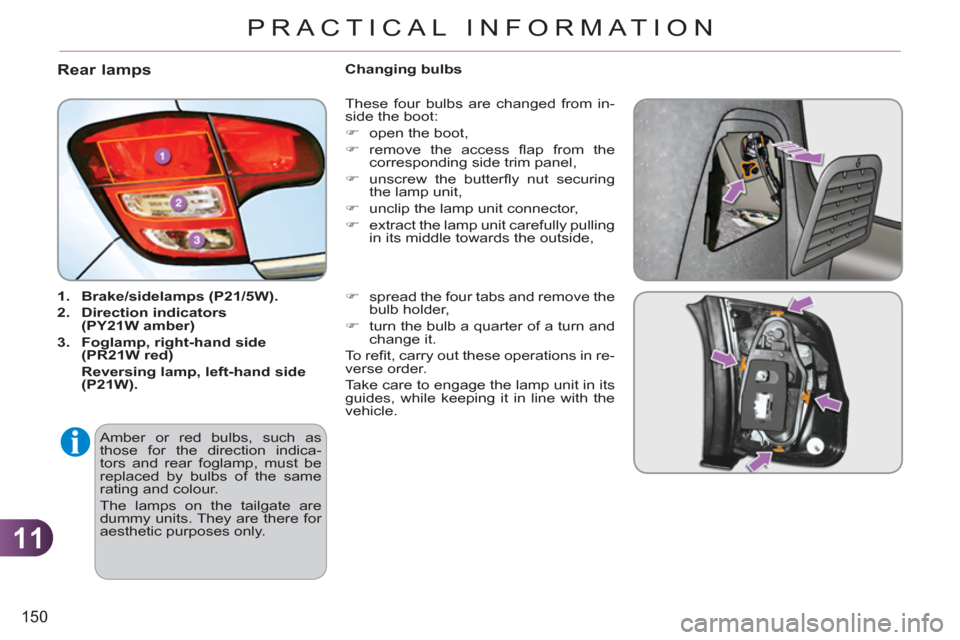
11
150
PRACTICAL INFORMATION
Rear lamps
1.
Brake/sidelamps (P21/5W).
2.
Direction indicators
(PY21W amber)
3.
Foglamp, right-hand side
(PR21W red)
Reversing lamp, left-hand side
(P21W).
These four bulbs are changed from in-
side the boot:
�)
open the boot,
�)
remove the access fl ap from the
corresponding side trim panel,
�)
unscrew the butterfl y nut securing
the lamp unit,
�)
unclip the lamp unit connector,
�)
extract the lamp unit carefully pulling
in its middle towards the outside,
�)
spread the four tabs and remove the
bulb holder,
�)
turn the bulb a quarter of a turn and
change it.
To r efi t, carry out these operations in re-
verse order.
Take care to engage the lamp unit in its
guides, while keeping it in line with the
vehicle.
Changing bulbs
Amber or red bulbs, such as
those for the direction indica-
tors and rear foglamp, must be
replaced by bulbs of the same
rating and colour.
The lamps on the tailgate are
dummy units. They are there for
aesthetic purposes only.
Page 155 of 252
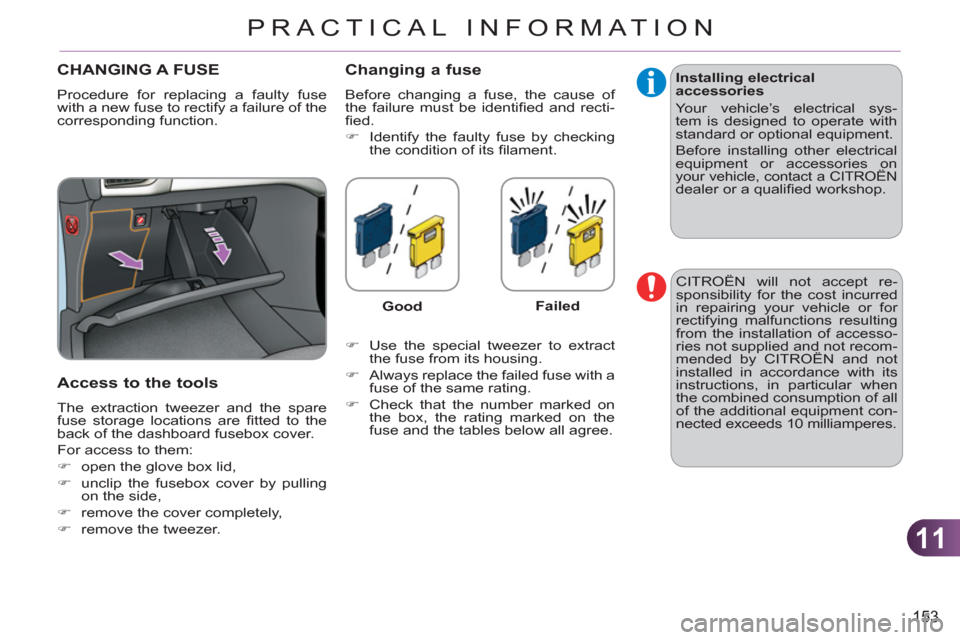
11
153
PRACTICAL INFORMATION
CHANGING A FUSE
Procedure for replacing a faulty fuse
with a new fuse to rectify a failure of the
corresponding function.
Access to the tools
The extraction tweezer and the spare
fuse storage locations are fi tted to the
back of the dashboard fusebox cover.
For access to them:
�)
open the glove box lid,
�)
unclip the fusebox cover by pulling
on the side,
�)
remove the cover completely,
�)
remove the tweezer.
Changing a fuse
Before changing a fuse, the cause of
the failure must be identifi ed and recti-
fi ed.
�)
Identify the faulty fuse by checking
the condition of its fi lament.
Good
Failed
�)
Use the special tweezer to extract
the fuse from its housing.
�)
Always replace the failed fuse with a
fuse of the same rating.
�)
Check that the number marked on
the box, the rating marked on the
fuse and the tables below all agree.
Installing electrical
accessories
Your vehicle’s electrical sys-
tem is designed to operate with
standard or optional equipment.
Before installing other electrical
equipment or accessories on
your vehicle, contact a CITROËN dealer or a qualifi ed workshop.
CITROËN will not accept re-
sponsibility for the cost incurred
in repairing your vehicle or for
rectifying malfunctions resulting
from the installation of accesso-
ries not supplied and not recom-
mended by CITROËN and not
installed in accordance with its
instructions, in particular when
the combined consumption of all
of the additional equipment con-
nected exceeds 10 milliamperes.
Page 158 of 252
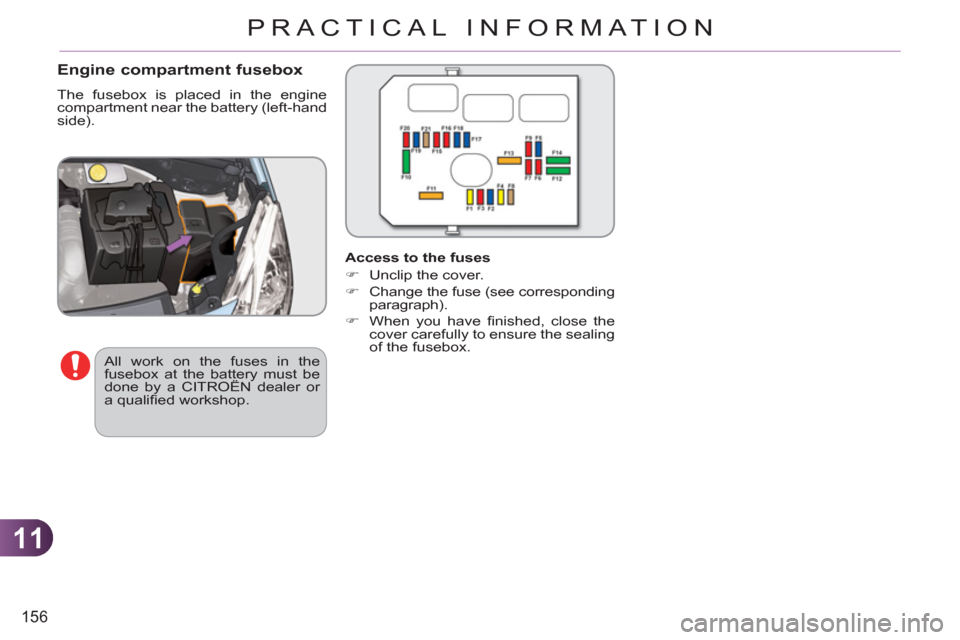
11
156
PRACTICAL INFORMATION
Engine compartment fusebox
The fusebox is placed in the engine
compartment near the battery (left-hand
side).
Access to the fuses
�)
Unclip the cover.
�)
Change the fuse (see corresponding
paragraph).
�)
When you have fi nished, close the
cover carefully to ensure the sealing
of the fusebox.
All work on the fuses in the
fusebox at the battery must be
done by a CITROËN dealer or
a qualifi ed workshop.
Page 159 of 252
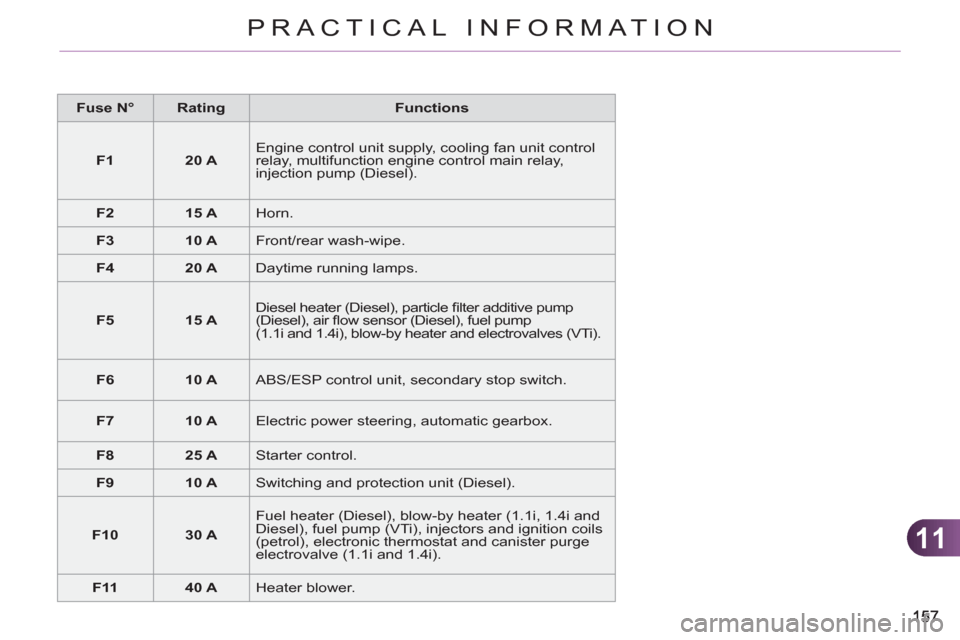
11
PRACTICAL INFORMATION
Fuse N°
Rating
Functions
F1
20 A
Engine control unit supply, cooling fan unit control
relay, multifunction engine control main relay,
injection pump (Diesel).
F2
15 A
Horn.
F3
10 A
Front/rear wash-wipe.
F4
20 A
Daytime running lamps.
F5
15 A
Diesel heater (Diesel), particle fi lter additive pump
(Diesel), air fl ow sensor (Diesel), fuel pump
(1.1i and 1.4i), blow-by heater and electrovalves (VTi).
F6
10 A
ABS/ESP control unit, secondary stop switch.
F7
10 A
Electric power steering, automatic gearbox.
F8
25 A
Starter control.
F9
10 A
Switching and protection unit (Diesel).
F10
30 A
Fuel heater (Diesel), blow-by heater (1.1i, 1.4i and
Diesel), fuel pump (VTi), injectors and ignition coils
(petrol), electronic thermostat and canister purge
electrovalve (1.1i and 1.4i).
F11
40 A
Heater blower.
Page 160 of 252

11
158
PRACTICAL INFORMATION
Fuse N°
Rating
Functions
F12
30 A
Windscreen wipers slow/fast speed.
F13
40 A
Built-in systems interface supply (ignition positive).
F14
30 A
Valvetronic supply (VTi).
F15
10 A
Right-hand main beam headlamps.
F16
10 A
Left-hand main beam headlamps.
F17
15 A
Left-hand dipped beam headlamps.
F18
15 A
Right-hand dipped beam headlamps.
F19
15 A
Oxygen sensors and electrovalves (VTi),
electrovalves (Diesel), EGR electrovalve (Diesel).
F20
10 A
Pumps, electronic thermostat (VTi), water in fuel
sensor (Diesel).
F21
5 A
Fan assembly control supply, ABS/ESP.
Page 161 of 252
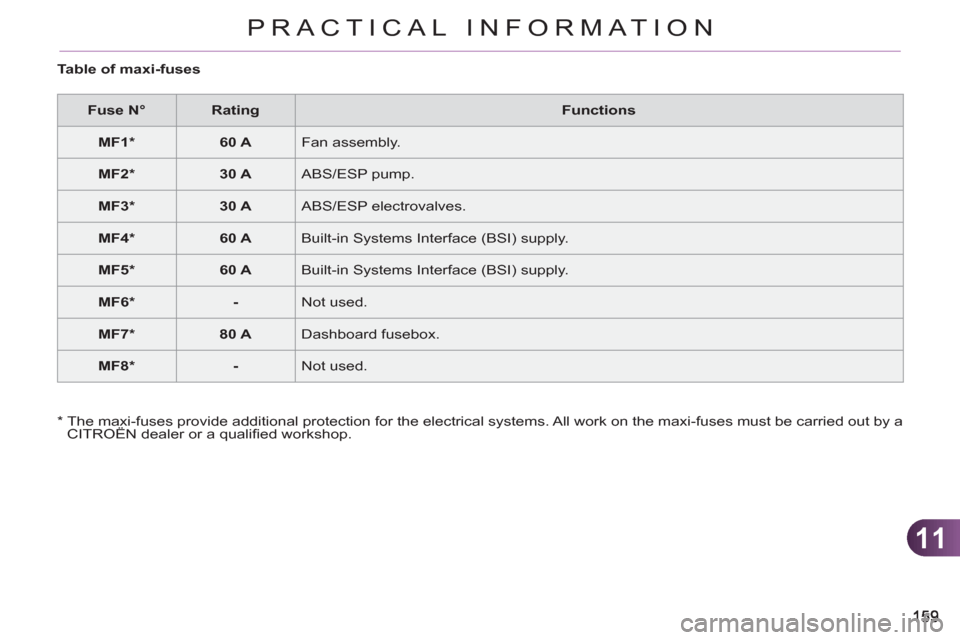
11
PRACTICAL INFORMATION
Table of maxi-fuses
Fuse N°
Rating
Functions
MF1 *
60 A
Fan assembly.
MF2 *
30 A
ABS/ESP pump.
MF3 *
30 A
ABS/ESP electrovalves.
MF4 *
60 A
Built-in Systems Interface (BSI) supply.
MF5 *
60 A
Built-in Systems Interface (BSI) supply.
MF6 *
-
Not used.
MF7 *
80 A
Dashboard fusebox.
MF8 *
-
Not used.
*
The maxi-fuses provide additional protection for the electrical systems. All work on the maxi-fuses must be carried out by a
CITROËN dealer or a qualifi ed workshop.